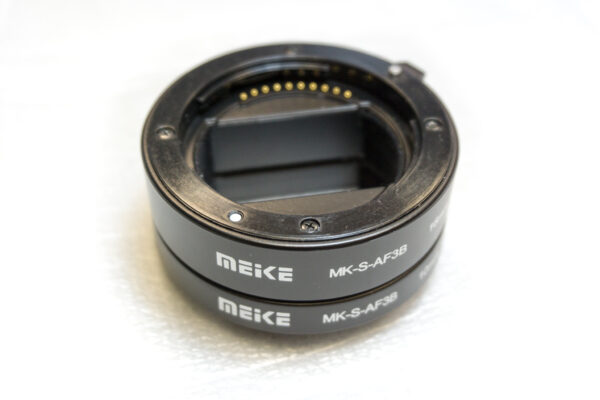
The Sony Alpha a6000’s kit lens, the SELP1650 16-50mm f/3.5-5.6 OSS lens, doesn’t focus very near. It has a minimum focus distance of about 25 cm, which makes it unsuitable for close-up macro shots. Conventionally, you’d need to get a macro lens. There are cheaper alternatives though, and one of them is to use a macro extension tube.
An extension tube sits between the camera body and a standard lens. It increases the distance between the lens and the camera sensor. This additional distance enables the lens to focus more closely, resulting in greater image magnification.
Extension tubes are relatively cheap, because they contain no optics. I bought the Meike Macro Extension Tube with a Sony E-mount for US$26.50. This is an automatic extension tube, which includes electrical contacts to transfer signals between the camera body and the lens. This means that you can shoot with auto-focus and aperture setting controlled from the camera.
To illustrate the macro close-up capabilities, I’ve taken a series of photos shown below. The first shows a twenty cent coin taken from about 20 cm away. The lens is zoomed in to 35 mm.
The next photo is also without the macro extension tube. This time, the SELP1650 is zoomed in fully to 50 mm. Although zooming in should bring the subject closer, unfortunately the lens was unable to focus unless I pulled the camera further away from the subject. This time, distance from subject to the sensor is about 25 cm.
Clearly, zoom or not, the SELP1650 lens won’t get close enough, or magnify large enough, smallish subjects. Now, let’s take a look at what the Meike extension tubes do. The next photo below is shot with the 10 mm extension tube. The SELP1650 lens is set at 35 mm. Distance from subject to the sensor is about 11 cm.
The 10 mm extension tube manages to bring the five cent coin much closer.
Next, I switched to the 16 mm extension tube. The lens is still zoomed in at 35 mm, and the subject distance remains the same at about 11 cm from the sensor. The front element of the lens, of course, has gotten closer to the subject.
Finally, the next photo is shot with both extension tubes. Yes, you can stack the tubes together, so now I have an effective extension of 26 mm. The SELP1650 lens is still zoomed in at 35 mm, and subject distance from sensor is the same, but a whole lot closer to the front element of the lens now.
Notice that the depth of field is awfully shallow in the above shot. This is a five cent coin that measures only 17 mm in diameter. The aperture was set at f/8. I think in practice you’d have to stop the aperture down much further to get a usable depth of field.
While extension tubes have no optical parts to affect the image quality, they do reduce the amount of falling on the sensor. This means that you’d either have to shoot with a larger aperture, or make sure you have enough lights on the subject.
Another disadvantage of extension tubes in general is that you may find it cumbersome to put them on and take them off. You also typically cannot focus on distant objects. Furthermore, high magnification images may lack quality simply because your original lens wasn’t designed for such levels of magnification. This is a different issue from the extension tube not having an optical lens to affect the image per se.
This Meike Macro Extension Tube for E-mount cameras cost US$26.50. It’s a whole lot more economical than getting a new macro lens.
Another alternative for macro photography, apart from macro lenses and extension tubes, is to use macro filters. I’ll save this for another post.
Conclusion
The Meike Macro Extension Tube for E-mount cameras is a budget alternative to dedicated macro lenses for close-up macro photography.
Pros:
- Electrical contacts to enable auto-focus and aperture setting on original lens
- Lightweight
Cons:
- Plasticky body feels cheap
There are, of course, other general advantages and disadvantages with macro extension tubes already discussed, and which are not specific characteristics of this Meike product.
